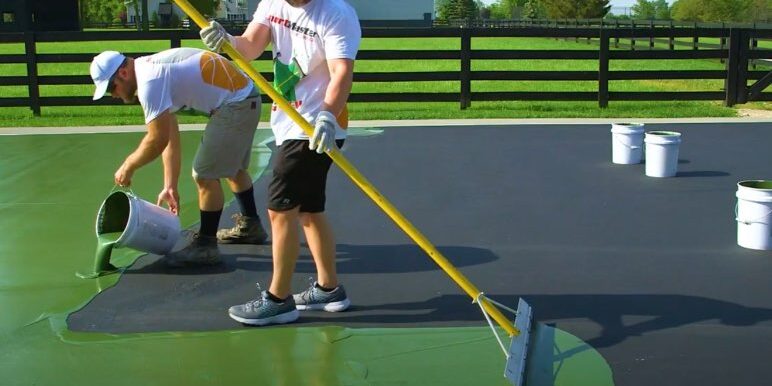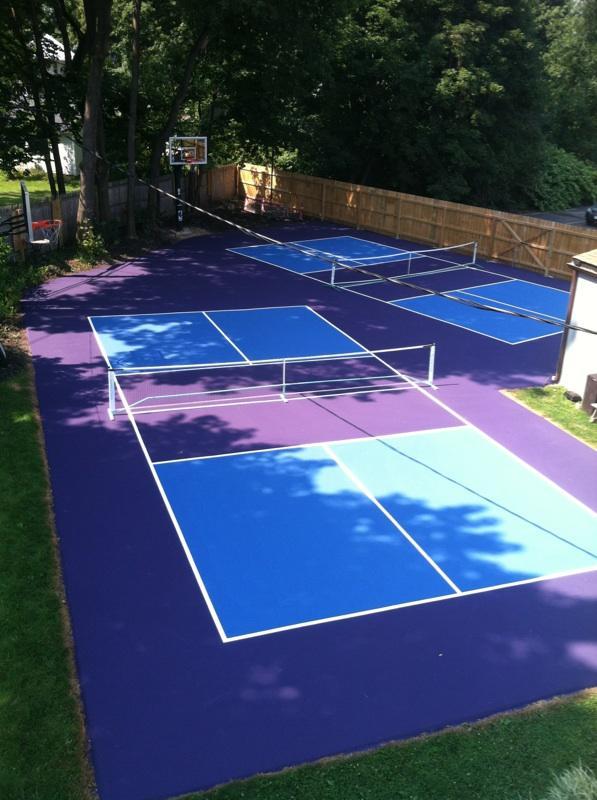A Comprehensive Overview to Creating the Perfect Pickleball Court for All Ability Degrees
Designing a pickleball court that caters to players of varying skill degrees necessitates a diverse technique, incorporating important components such as court measurements, surface materials, and availability functions. What details considerations must be focused on to make sure a successful application?

Recognizing Court Dimensions
Understanding the dimensions of a pickleball court is essential for both designers and gamers, as these specifications guarantee a fair and constant having fun experience. A conventional pickleball court gauges 20 feet vast by 44 feet long for both songs and increases play. The court is separated right into two equivalent fifty percents by an internet that stands 36 inches high at the sidelines and 34 inches at the center.
Secret attributes of the court include the non-volley zone, generally described as the "cooking area," which prolongs 7 feet from the net on both sides. This area is essential for controling player motion and volleying, making sure calculated play. Additionally, the solution areas on each side of the court are vital, determining 10 feet wide and 15 feet deep, made to accommodate appropriate offering strategies.
Surrounding the court, a location of at the very least 10 feet should be assigned as the security zone, enabling gamers ample room to relocate and protect against injuries throughout play. Complying with these dimensions not only cultivates reasonable competitors but also advertises safety and security and satisfaction for all participants, making it important for any kind of pickleball court layout.
Picking the Right Surface
The choice of playing surface for a pickleball court substantially affects the game's characteristics and gamer experience. Selecting the appropriate product is essential for ensuring player performance, comfort, and safety and security. Common surfaces include asphalt, concrete, and specialized sports floor covering.
Asphalt is a preferred choice as a result of its affordability and sturdiness. It supplies a consistent playing surface yet can be difficult on joints over prolonged play. Concrete, while comparable in resilience, provides minimal adaptability, possibly leading to raised influence on gamers' bodies.
For a much more cushioned experience, numerous facilities decide for customized sports floor covering, such as artificial surface areas or modular floor tiles. These products commonly consist of shock-absorbing properties, decreasing the threat of injuries and boosting player comfort. Moreover, such surface areas can enhance ball bounce uniformity, which is vital for reasonable play.
When selecting a surface area, take into consideration variables such as environment, upkeep needs, and the intensity of play. A well-chosen surface not just boosts gameplay yet additionally contributes to the longevity of the court itself. Eventually, understanding the subtleties of different materials will certainly aid in creating an optimum pickleball atmosphere customized to numerous skill degrees.
Optimal Court Design
An optimal court format is crucial for maximizing both player performance and spectator pleasure in pickleball. The measurements of a standard pickleball court are 20 feet wide by 44 feet long for doubles play, maintaining a clear border that enhances gameplay. The net, positioned at 36 inches high at the my website sidelines and 34 inches in the center, is crucial for maintaining the dynamics of the game.
Including assigned locations around the court for players to relocate easily is vital. A minimum of 10 feet of clearance on all sides of the court is recommended to avoid collisions and supply room for viewers. In addition, orientation plays a considerable function; the court must ideally be aligned north-south to decrease the influence of sun glare on players during top hours.
Effective viewer placement is just as crucial. Raised seeing bleachers or locations positioned behind the sidelines can improve the experience while making sure security. Visible and clear court markings help in gameplay, with contrasting colors for limits and non-volley areas that mark essential areas for players. In general, a properly designed court layout fosters an appealing atmosphere for both viewers and players.

Access Considerations
When making a you could try here pickleball court, making sure accessibility for all gamers, including those with handicaps, is extremely important. A thoughtfully designed court can cultivate inclusivity and urge engagement from people of differing abilities.

Access courses to the court need to likewise be carefully intended. Make sure that pathways bring about the court are broad enough for wheelchair users and are geared up with ramps where essential. Signs needs to be big and clear enough to be conveniently checked out.
Additionally, seating locations need to be made to enable easy access to and from the court. This consists of providing marked rooms for viewers who might have wheelchair challenges.
Last but not least, guarantee that bathroom centers neighboring satisfy ease of access criteria. By thinking about these aspects, you can develop a pickleball court that is inviting and usable for every person, therefore promoting a vivid and varied area of players.
Maintenance and Maintenance
Appropriate upkeep and upkeep of a pickleball court are essential for guaranteeing ideal having fun problems and prolonging the lifespan of the center. Regular examinations ought to be carried out to identify and resolve any kind of problems or use, such as fractures in the surface or loosened netting. These problems, if left ignored, can negatively influence gameplay and safety and security.
Surface area maintenance is critical; courts ought to be cleansed frequently to eliminate debris, leaves, or dust that can influence traction. For hard courts, routine pressure i was reading this cleaning is advised to keep surface integrity and appearances. If your court is constructed from softer products, such as asphalt, resurfacing or sealing may be required to safeguard against weather-related wear.
Additionally, web height and tension should be checked routinely, as inappropriate setups can modify gameplay. Keeping bordering locations, including fence and lighting, is equally important for guaranteeing a risk-free and delightful setting.
Conclusion
In conclusion, the layout of a suitable pickleball court necessitates a thorough approach that incorporates appropriate dimensions, appropriate surface area products, and thoughtful format. By adhering to these standards, the excellent pickleball court can be created, advertising enjoyment and sports growth for gamers of varying skill levels.
Designing a pickleball court that provides to gamers of differing skill degrees requires a multifaceted approach, including important components such as court dimensions, surface materials, and ease of access features.Comprehending the dimensions of a pickleball court is essential for both developers and players, as these requirements make sure a reasonable and consistent playing experience.The selection of playing surface area for a pickleball court considerably influences the game's dynamics and gamer experience.An ideal court design is necessary for optimizing both player performance and viewer enjoyment in pickleball. By sticking to these guidelines, the ideal pickleball court can be created, advertising enjoyment and athletic growth for players of differing ability degrees.